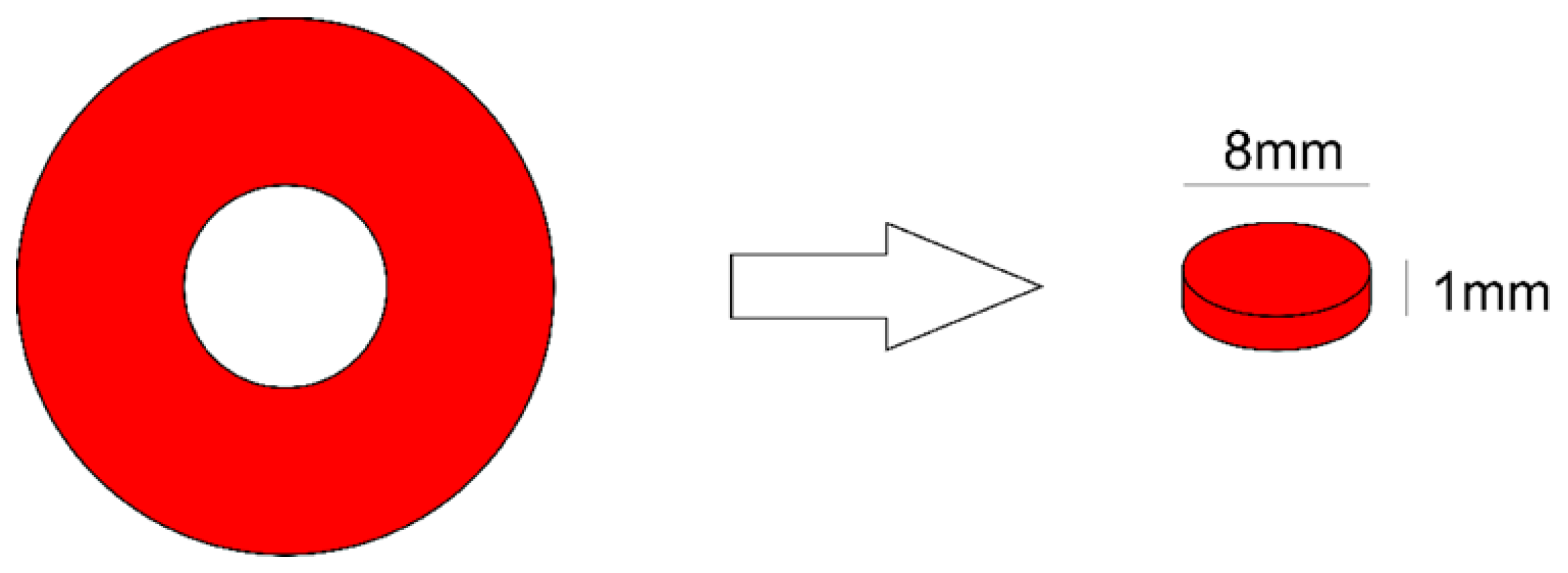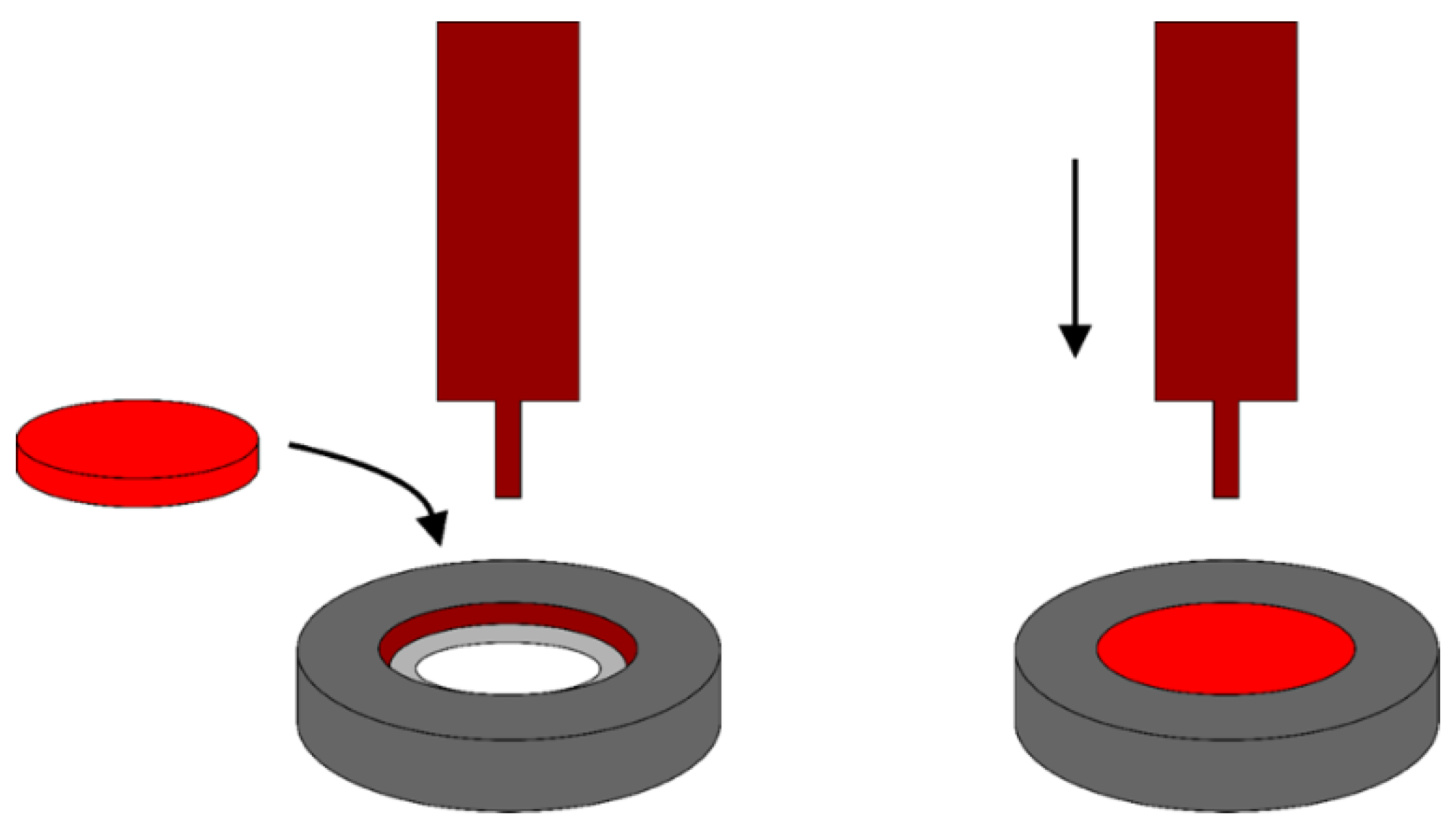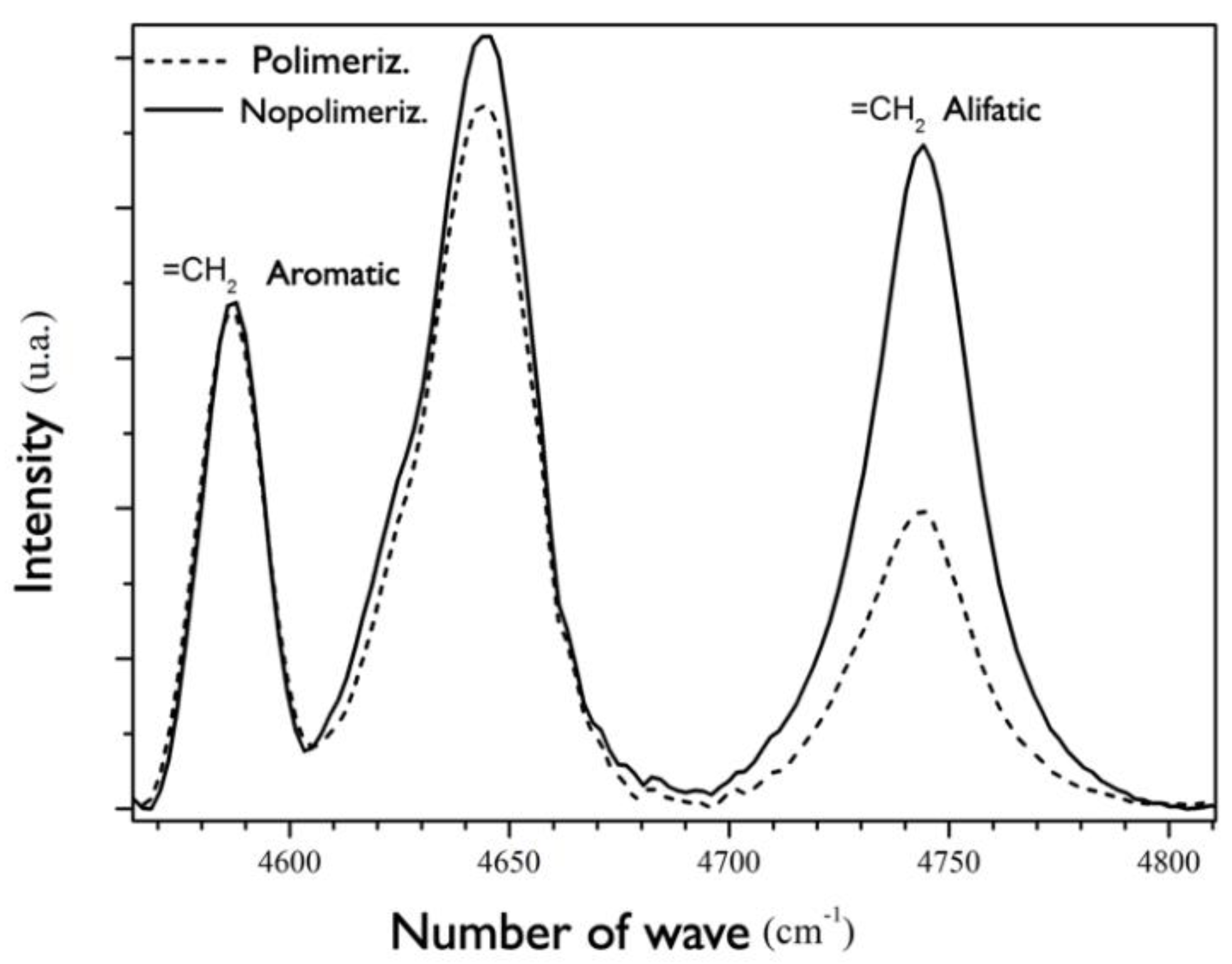Effect of Curing Modes on the Mechanical Properties of Commercial Dental Resin-Based Composites: Comparison between Different LEDs and Microwave Units
Abstract
:1. Introduction
2. Materials and Methods
2.1. Biaxial Flexure Strength Test
2.2. Degree of Conversion
2.3. Statistical Analysis
3. Results
4. Discussion
5. Conclusions
- The type of resin-based composite showed different flexure strength values;
- The curing mode did not affect the flexure strength of resin-based composites;
- The shade of resin-based composites did not interfere with the flexure strength;
- The degree of conversion of resin-based composites was not affected by the curing unit used, except for Vittra E Bleach.
Author Contributions
Funding
Conflicts of Interest
References
- Ferracane, J.L. Models of Caries Formation around Dental Composite Restorations. J. Dent. Res. 2017, 96, 364–371. [Google Scholar] [CrossRef] [PubMed]
- Ferracane, J.L. Resin composite—State of the art. Dent. Mater. 2011, 27, 29–38. [Google Scholar] [CrossRef] [PubMed]
- Leprince, J.G.; Palin, W.M.; Hadis, M.A.; Devaux, J.; Lehoup, G. Progress in dimethacrylate-based dental composite technology and curing efficiency. Dent. Mater. 2013, 29, 139–156. [Google Scholar] [CrossRef] [PubMed]
- Munhoz, T.; Fredholm, Y.; Rivory, P.; Balvay, S.; Hartmann, D.; Silva, P.; Chenal, J. Effect of nanoclay addition on physical, chemical, optical and biological properties of experimental dental resin composites. Dent. Mater. 2017, 33, 271–279. [Google Scholar] [CrossRef]
- Aydınoğlu, A.; Yoruç, A.B.H. Effects of silane-modified fillers on properties of dental composite resin. Mater. Sci. Eng. C Mater. Biol. Appl. 2017, 1, 382–389. [Google Scholar] [CrossRef]
- Brown, K.M.; Gillespie, G. Advancements in Composite Resin Material Enable Streamlined Direct Restoration Process. Compend. Contin. Educ. Dent. 2019, 40, 2–6. [Google Scholar] [PubMed]
- Balbinot, E.D.C.A.; Pereira, M.F.C.C.; Skupien, J.A.; Balbinot, C.E.A.; da Rocha, G.; Vieira, S. Analysis of transmittance and degree of conversion of composite resins. Microsc. Res. Tech. 2019, 82, 1953–1961. [Google Scholar] [CrossRef] [PubMed]
- Lucey, S.M.; Santini, A.; Roebuck, E.M. Degree of conversion of resin-based materials cured with dual-peak or single-peak LED light-curing units. Int. J. Paediatr. Dent. 2015, 25, 93–102. [Google Scholar] [CrossRef]
- Cardoso, K.A.; Zarpellon, D.C.; Madruga, C.F.; Rodrigues, J.A.; Arrais, C.A. Effects of radiant exposure values using second and third generation light curing units on the degree of conversion of a lucirin-based resin composite. J. Appl. Oral Sci. 2017, 25, 140–146. [Google Scholar] [CrossRef]
- Manojlovic, D.; Dramićanin, M.D.; Lezaja, M.; Pongprueksa, P.; Van Meerbeek, B.; Miletic, V. Effect of resin and photoinitiator on color, translucency and color stability of conventional and low-shrinkage model composites. Dent. Mater. 2016, 32, 183–191. [Google Scholar] [CrossRef]
- Rueggeberg, F.A. State-of-the-art: Dental photocuring—A review. Dent. Mater. 2011, 27, 39–52. [Google Scholar] [CrossRef] [PubMed]
- Beun, S.; Glorieux, T.; Devaux, J.; Vreven, J.; Leloup, G. Characterization of nanofilled compared to universal and microfilled composites. Dent. Mater. 2007, 23, 51–59. [Google Scholar] [CrossRef] [PubMed]
- Da Silva, E.M.; Poskus, L.T.; Guimarães, J.G. Influence of light-polymerization modes on the degree of conversion and mechanical properties of resin composites: A comparative analysis between a hybrid and a nanofilled composite. Oper. Dent. 2008, 33, 287–293. [Google Scholar] [CrossRef] [PubMed]
- Kaprielian, N.; Lagneau, C.; Zydowicz, N.; Lissac, M.; Grosgogeat, B. Effect of type of polymerization on different properties of dental composites. Biomed. Mater. Eng. 2005, 15, 483–493. [Google Scholar] [PubMed]
- Munshi, N.; Rosenblum, M.; Jiang, S.; Flinton, R. In Vitro Wear Resistance of Nano-Hybrid Composite Denture Teeth. J. Prosthodont. 2017, 26, 224–229. [Google Scholar] [CrossRef] [PubMed]
- Kowalska, A.; Sokolowski, J.; Bociong, K. The Photoinitiators Used in Resin Based Dental Composite-A Review and Future Perspectives. Polymers 2021, 13, 470. [Google Scholar] [CrossRef]
- Lara, L.; Rocha, M.G.; Menezes, L.R.; Correr, A.B.; Sinhoreti, M.A.C.; Oliveira, D. Effect of combining photoinitiators on cure efficiency of dental resin-based composites. J. Appl. Oral Sci. 2021, 29, e20200467. [Google Scholar] [CrossRef] [PubMed]
- Ilie, N.; Hickel, R. Resin composite restorative materials. Aust. Dent. J. 2011, 56, 59–66. [Google Scholar] [CrossRef]
- Zimmerli, B.; Strub, M.; Jeger, F.; Stadler, O.; Lussi, A. Composite materials: Composition, properties and clinical applications. A literature review. Schweiz. Monatsschr. Zahnmed. 2010, 120, 972–986. [Google Scholar]
- Santini, A.; Miletic, V.; Swift, M.D.; Bradley, M. Degree of conversion and microhardness of TPO-containing resin-based composites cured by polywave and monowave LED units. J. Dent. 2012, 40, 577–584. [Google Scholar] [CrossRef]
- Porto, I.C.; Soares, L.E.; Martin, A.A.; Cavalli, V.; Liporoni, P.C. Influence of the photoinitiator system and light photoactivation units on the degree of conversion of dental composites. Braz. Oral Res. 2010, 24, 475–481. [Google Scholar] [CrossRef] [PubMed] [Green Version]
- Galvão, M.R.; Caldas, S.G.; Bagnato, V.S.; de Souza Rastelli, A.N.; de Andrade, M.F. Evaluation of degree of conversion and hardness of dental composites photo-activated with different light guide tips. Eur. J. Dent. 2013, 7, 86–93. [Google Scholar] [PubMed]
- Catelan, A.; de Araújo, L.S.; da Silveira, B.C.; Kawano, Y.; Ambrosano, G.M.; Marchi, G.M.; Aguiar, F.H. Impact of the distance of light curing on the degree of conversion and microhardness of a composite resin. Acta Odontol. Scand. 2015, 73, 298–301. [Google Scholar] [CrossRef] [PubMed]
- Rueggeberg, F.A.; Cole, M.A.; Looney, S.W.; Vickers, A.; Swift, E.J. Comparison of manufacturer-recommended exposure durations with those determined using biaxial flexure strength and scraped composite thickness among a variety of light-curing units. J. Esthet. Restor. Dent. 2009, 21, 43–61. [Google Scholar] [CrossRef]
- Siagian, J.S.; Dennis, D.; Ikhsan, T.; Abidin, T. Effect of Different LED Light-curing Units on Degree of Conversion and Microhardness of Bulk-fill Composite Resin. J. Contemp. Dent. Pract. 2020, 21, 615–620. [Google Scholar]
- Silva, A.A.; Veeck, E.B.; Oliveira, J.P.; Souza, P.H. Comparison of chemical composition of packable resin composites by scanning electron microscopy. J. Appl. Oral Sci. 2005, 13, 67–71. [Google Scholar] [CrossRef]
- Neumann, M.G.; Schmitt, C.C.; Ferreira, G.C.; Corrêa, I.C. The initiating radical yields and the efficiency of polymerization for various dental photoinitiators excited by different light curing units. Dent. Mater. 2006, 22, 576–584. [Google Scholar] [CrossRef]
- Moldovan, M.; Balazsi, R.; Soanca, A.; Roman, A.; Sarosi, C.; Prodan, D.; Vlassa, M.; Cojocaru, I.; Saceleanu, V.; Cristescu, I. Evaluation of the Degree of Conversion, Residual Monomers and Mechanical Properties of Some Light-Cured Dental Resin Composites. Materials 2019, 12, 2109. [Google Scholar] [CrossRef]
- Milosevic, A. Clinical guidance and an evidence-based approach for restoration of worn dentition by direct composite resin. Br. Dent. J. 2018, 224, 301–310. [Google Scholar] [CrossRef]
- Berger, S.B.; Petri, Z.; Hass, V.; Guiraldo, R.D.; Favaro, J.C.; Lopes, M.B.; González, A.H. Effect of whitening mouthrinses on bulk-fill composites. Am. J. Dent. 2019, 32, 235–239. [Google Scholar]
- Grazioli, G.; Francia, A.; Cuevas-Suárez, C.E.; Zanchi, C.H.; Moraes, R.R. Simple and Low-Cost Thermal Treatments on Direct Resin Composites for Indirect Use. Braz. Dent. J. 2019, 30, 279–284. [Google Scholar] [CrossRef] [PubMed]



| RBC Trademark | Classification | Manufacturer |
|---|---|---|
| Charisma | Microhybrid | Heraeus Kulzer |
| Z100 | Microhybrid | 3M ESPE |
| Z250 | Microhybrid | 3M ESPE |
| Polofil Supra | Microhybrid | VOCO |
| Empress Direct | Nanohybrid | Ivoclar Vivadent |
| Harmonize | Nanohybrid | Kerr |
| Herculite Précis | Nanohybrid | Kerr |
| Amaris | Nanohybrid | VOCO |
| Admira Fusion | Nanohybrid | VOCO |
| Grandio | Nanohybrid | VOCO |
| GrandioSO | Nanohybrid | VOCO |
| Vittra | Nanofilled | FGM |
| Z350 | Nanofilled | 3M ESPE |
| Palfique LX5 | Supra-nanofilled | Tokuyama |
| RBC Trademarks | Shade A2 | Additional Curing | Effects Shade | ||||
|---|---|---|---|---|---|---|---|
| VALO | Emitter a Fit | Emitter Now Duo | Emitter a Fit + Microwave | VALO | Emitter a Fit | Emitter Now Duo | |
| Group 1 | Group 2 | Group 3 | Group 4 | Group 5 | Group 6 | Group 7 | |
| Charisma | 10 | 10 | - | - | - | - | - |
| Z100 | 10 | 10 | 10 | 10 | - | - | - |
| Z250 | 10 | 10 | - | - | - | - | - |
| Polofil Supra | 10 | 10 | - | - | - | - | - |
| Empress Direct | 10 | 10 | - | - | 10 | 10 | 10 |
| Harmonize | 10 | 10 | 10 | 10 | - | - | - |
| Herculite Précis | 10 | 10 | - | - | 10 | 10 | 10 |
| Amaris | 10 | 10 | - | - | 10 | 10 | 10 |
| Admira Fusion | 10 | 10 | - | - | 10 | 10 | 10 |
| Grandio | 10 | 10 | 10 | 10 | 20 | 20 | 20 |
| GrandioSO | 10 | 10 | - | - | 10 | 10 | 10 |
| Vittra | 10 | 10 | 10 | 10 | 10 | 10 | 10 |
| Z350 | 10 | 10 | 10 | 10 | 10 | 10 | - |
| Palfique LX5 | 10 | 10 | - | - | 10 | 10 | 10 |
| TOTAL | 140 | 140 | 50 | 50 | 100 | 100 | 90 |
| Photopolymerization Units | Classification | Wavelength |
|---|---|---|
| VALO | Third generation | 395–480 nm |
| Emitter Now Duo | Third generation | 385–515 nm |
| Emitter Fit A | Second generation | 420–480 nm |
| RBC Trademark | Emitter a Fit (1250 mW/cm2) | VALO (1100 mW/cm2) |
|---|---|---|
| Charisma A2 | 265.14 A 1,2 (±51.13) | 298.20 A 2,3 (±75.33) |
| Palfique A2 | 175.07 A 1 (±24.28) | 168.63 A 1 (±31.73) |
| Vittra A2 | 329.69 A 2,4 (±59.75) | 328.86 A 3 (±85.45) |
| Empress A2 | 203.17 A 1,3 (±40.03) | 186.95 A 1,2 (±54.38) |
| Z100 A2 | 307.04 A 2,3,4 (±29.16) | 363.85 A 3 (±81.17) |
| Z250 A2 | 329.93 A 2,4 (±126.23) | 363.16 A 3 (±81.17) |
| Z350 A2 | 375.28 A 2 (±83.16) | 355.32 A 3 (±90.56) |
| Harmonize A2 | 368.53 A 2 (±46.30) | 348.88 A 3 (±51.50) |
| Herculite Precis A2 | 268.12 A 1,2 (±74.46) | 301.68 A 2,3 (±71.03) |
| Polofil Supra A2 | 357.81 A 2 (±72.88) | 287.21 A 1,3 (±49.82) |
| Amaris O2 | 212.73 A 1,4 (±39.55) | 185.97 A 1,2 (±30.97) |
| Admira Fusion A2 | 227.02 A 1,4 (±53.09) | 224.06 A 1,2,4 (±31.14) |
| GrandioSO A2 | 379.65 A 2 (±91.65) | 299.53 A 2,3 (±58.59) |
| Grandio A2 | 381.51 A 2 (±53.34) | 328.27 A 3,4 (±70.17) |
| RBC Trademark | Emitter a Fit | Emitter a Fit + Microwave |
|---|---|---|
| Z350 A2 | 375.28 (±83.16) | 334.99 (±50.19) |
| Z100 A2 | 307.04 (±29.14) | 317.42 (±83.02) |
| Grandio A2 | 381.51 (±53.84) | 301.08 (±76.42) |
| Harmonize A2 | 368.53 (±46.30) | 346.81 (±49.38) |
| Vittra A2 | 329.69 (±59.75) | 251.58 (±59.62) |
| RBC Trademark | Emitter a Fit | VALO | Emitter Now Duo |
|---|---|---|---|
| Palfique CE | 187.69 A 1 (±32.11) | 163.00 A 1,5 (±26.76) | 183.50 A 1 (±46.70) |
| Z350 GT | 365.93 A 2,3 (±62.08) | 385.28 A 2 (±72.85) | ----- |
| Herculite precis LTI | 295.45A1,2,3 (±66.87) | 297.55 A 2,3 (±51.80) | 308.10 A 2,3 (±79.27) |
| Grandio Incisal | 358.81 A 2,3 (±52.58) | 309.01 A 2,4 (±33.96) | 321.41 A 2 (±111.78) |
| Empress BL-L | 223.61 A 1,3 (±50.46) | 175.06 A 1,3 (±66.43) | 136.35 A 1 (±42.99) |
| Amaris Translúcida | 211.48 A 1,3 (±50.81) | 197.81 A 1,3,4 (±34.14) | 190.60 A 1,3 (±53.80) |
| Admira fusion Incisal | 241.63 A 3 (±42.26) | 207.76 A 1,3,4 (±52.76) | 153.87 A 1 (±39.51) |
| Grandio BL | 325.16 A 3 (±63.08) | 310.57 A 4,5,6 (±60.64) | 316.52 A 2 (±109.39) |
| GrandioSO BL | 315.55 A 3 (±64.50) | 292.31 A 2,3,4 (±79.83) | 308.31 A 2,3 (±59.65) |
| Vittra E Bleach | 310.73 A 1,3 (±88.72) | 394.57 A 2,6 (±115.73) | 306.97 A 2,3 (±117.74) |
| RBC Trademark | Emitter a Fit | VALO | Emitter Now Duo | |||
|---|---|---|---|---|---|---|
| Shade A2 | Effect Shade | Shade A2 | Effect Shade | Shade A2 | Effect Shade | |
| Palfique | 175.07 (±24.28) | 187.69 (±32.11) | 168.63 (±31.73) | 163.00 (±26.76) | ----- | 183.5 (±46.70) |
| Z350 | 375.28 (±83.16) | 365.93 (±62.08) | 298.2 (±75.33) | 385.28 (±72.85) | 297.72 (±51.80) | ----- |
| Herculite precis | 268.12 (±74.46) | 295.45 (±66.87) | 186.95 (±54.38) | 297.55 (±51.80) | ----- | 308.10 (±79.27) |
| Grandio | 381.51 (±53.34) | 358.81 (±52.58) | 363.85 (±81.17) | 309.01 (±33.96) | 332.05 (±63.81) | 321.41 (±111.78) |
| Empress | 203.17 (±40.03) | 223.61 (±50.46) | 363.16 (±81.17) | 175.06 (±66.43) | ----- | 136.35 (±42.99) |
| Amaris | 212.73 (±39.55) | 211.48 (±50.81) | 355.32 (±90.56) | 197.81 (±34.14) | ----- | 190.6 (±53.80) |
| Admisa fusion | 227.02 (±53.09) | 241.63 (±42.26) | 348.88 (±51.50) | 207.76 (±52.76) | ----- | 153.87 (±39.51) |
| GrandioSO | 379.65 (±91.65) | 315.55 (±64.80) | 301.68 (±71.03) | 292.31 (±79.83) | ----- | 308.31 (±59.65) |
| Vittra | 329.69 (±59.75) | 310.73 (±88.72) | 287.21 (±49.82) | 394.57 (±115.73) | 251.58 (±59.62) | 306.97 (±117.74) |
| RBC Trademark | Emitter a Fit | VALO | Emitter Now Duo |
|---|---|---|---|
| Admira Fusion Incisal | 53.1 | 54.2 | 51.6 |
| Admira Fusion A2 | 53.4 | 51.5 | 54.4 |
| Amaris Translúcido | 37.8 | 38.7 | 37.3 |
| Amaris O2 | 37.4 | 37.9 | 37.5 |
| Charisma A2 | 43.1 | 47.9 | 43.3 |
| Empress BL-L | 30.4 | 32.6 | 30.3 |
| Empress A2 | 38.1 | 34.3 | 30.9 |
| Grandio Incisal | 44.7 | 47.5 | 45.0 |
| Grandio BL | 43.3 | 43.3 | 41.8 |
| Grandio A2 | 42.2 | 44.0 | 40.4 |
| GransioSO BL | 45.9 | 46.8 | 46.8 |
| Grandioso A2 | 46.9 | 48.6 | 45.7 |
| Harmonize A2 | 43.7 | 47.9 | 44.1 |
| Herculite Précis A2 | 50.0 | 51.2 | 50.1 |
| Palfique LX5 CE | 34.8 | 35.3 | 37.1 |
| Palfique A2 | 40.1 | 42.8 | 39.6 |
| Polofil Supra A2 | 58.2 | 56.3 | 54.8 |
| Vittra E Bleach | 31.3 | 66.2 | 48.5 |
| Vittra A2 | 42.8 | 50.0 | 35.9 |
| Z100 A2 | 40.0 | 39.5 | 38.2 |
| Z250 A2 | 49.3 | 48.3 | 47.4 |
| Z350 GT | 51.1 | 50.0 | 51.0 |
| Z350 A2 | 44.6 | 50.6 | 46.1 |
Publisher’s Note: MDPI stays neutral with regard to jurisdictional claims in published maps and institutional affiliations. |
© 2022 by the authors. Licensee MDPI, Basel, Switzerland. This article is an open access article distributed under the terms and conditions of the Creative Commons Attribution (CC BY) license (https://creativecommons.org/licenses/by/4.0/).
Share and Cite
Vermudt, A.; Kuga, M.C.; Besegato, J.F.; Oliveira, E.C.G.d.; Leandrin, T.P.; Só, M.V.R.; Moraes, J.C.S.; Pereira, J.R. Effect of Curing Modes on the Mechanical Properties of Commercial Dental Resin-Based Composites: Comparison between Different LEDs and Microwave Units. Polymers 2022, 14, 4020. https://doi.org/10.3390/polym14194020
Vermudt A, Kuga MC, Besegato JF, Oliveira ECGd, Leandrin TP, Só MVR, Moraes JCS, Pereira JR. Effect of Curing Modes on the Mechanical Properties of Commercial Dental Resin-Based Composites: Comparison between Different LEDs and Microwave Units. Polymers. 2022; 14(19):4020. https://doi.org/10.3390/polym14194020
Chicago/Turabian StyleVermudt, Alef, Milton Carlos Kuga, João Felipe Besegato, Eliane Cristina Gulin de Oliveira, Thaís Piragine Leandrin, Marcus Vinicius Reis Só, João Carlos Silos Moraes, and Jefferson Ricardo Pereira. 2022. "Effect of Curing Modes on the Mechanical Properties of Commercial Dental Resin-Based Composites: Comparison between Different LEDs and Microwave Units" Polymers 14, no. 19: 4020. https://doi.org/10.3390/polym14194020
APA StyleVermudt, A., Kuga, M. C., Besegato, J. F., Oliveira, E. C. G. d., Leandrin, T. P., Só, M. V. R., Moraes, J. C. S., & Pereira, J. R. (2022). Effect of Curing Modes on the Mechanical Properties of Commercial Dental Resin-Based Composites: Comparison between Different LEDs and Microwave Units. Polymers, 14(19), 4020. https://doi.org/10.3390/polym14194020








